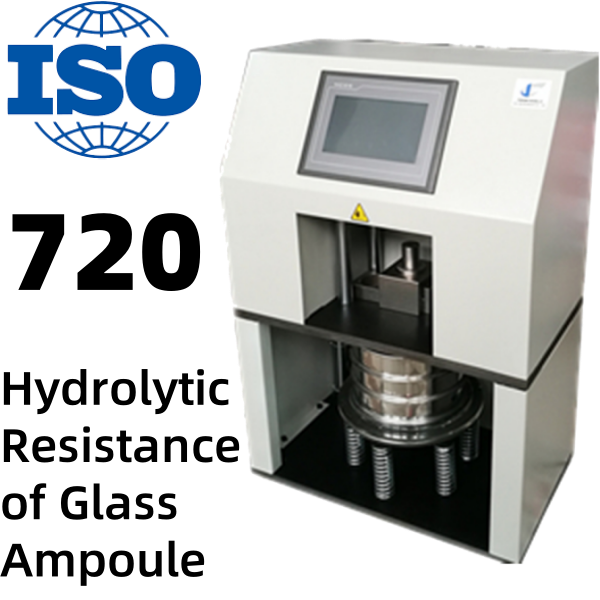ISO 720 Hydrolytic Resistance
of Glass Ampoule
The ISO 720 standard outlines a critical method for evaluating the hydrolytic resistance of glass containers, especially those used in pharmaceutical packaging like glass ampoules. This test ensures that the chemical stability of glass is maintained when exposed to high temperatures and water, preserving the integrity and safety of pharmaceutical products.
Understanding ISO 720 and Its Importance in the Pharmaceutical Industry
The ISO 720:2020 standard, titled Glass — Hydrolytic resistance of glass grains at 121 °C — Method of test and classification, provides a method for determining how much alkaline material glass releases under controlled conditions. This is essential for pharmaceutical manufacturers who rely on glass ampoules and vials to safely contain injectable drugs, oral solutions, and other critical medications.
Pharmaceutical glass packaging that releases excess alkali into its contents can alter drug composition, posing risks to patient safety. Hence, ISO 720 is a fundamental benchmark for material quality and regulatory compliance.
Hydrolytic Resistance of Glass Containers: Core Principles
Hydrolytic resistance of glass containers refers to a material’s ability to withstand chemical attack from water at elevated temperatures. The ISO 720 procedure involves:
- Crushing and sieving glass samples to a specific grain size (300–425 μm).
- Extracting alkali by heating the grains in grade 2 water at 121 °C for 30 minutes.
- Titrating the extracted solution with hydrochloric acid using a methyl red indicator.
The amount of acid consumed during titration quantifies the glass’s resistance. Higher acid consumption indicates higher alkali release, signifying lower resistance.
This test is critical for ampoules, vials, and bottles made from soda-lime or borosilicate glass, which are frequently used in sterile pharmaceutical packaging.
Glass Ampoules Testing According to ISO 720
Glass ampoules testing under ISO 720 is not just about passing a chemical durability test—it’s about ensuring compliance, product safety, and protecting end users. Here’s a brief breakdown of the key test phases:
- Sample Preparation: Ensure annealing is adequate. Wrap, crush, and sieve glass samples to achieve the specified size.
- Ultrasonic Cleaning: Use acetone and ultrasonic waves to thoroughly clean glass grains, removing contaminants.
- Drying: Dry at 140 °C for 20 minutes to remove residual moisture.
- Autoclaving: Subject the samples to a controlled temperature cycle reaching 121 °C.
- Titration and Evaluation: Measure the amount of acid needed to neutralize the extract solution, classifying the glass accordingly.
To ensure reproducibility and accuracy, this test demands precision handling and reliable sample preparation equipment.
Automated Support with the GHR-01A Glass Grain Hydrolytic Resistance Tester
Cell Instruments’ GHR-01A is designed to automate and optimize glass grain preparation for ISO 720 and ISO 719 testing. Its intelligent functions streamline the most challenging phases of the test—crushing, sieving, and safety handling.
Key Advantages of GHR-01A:
- Automated Crushing & Sieving: Delivers consistent particle size with minimal manual effort.
- Precision Control: Reduces variability, improves sample accuracy.
- Enhanced Safety: Protective features guard users against glass splinters.
- Eco-Friendly Design: Collects waste responsibly and reduces contamination risks.
- User-Friendly Interface: Intuitive operation via an HMI screen.
By automating key steps, the GHR-01A ensures repeatable, high-quality results—making it a valuable asset for pharmaceutical labs and packaging manufacturers aiming for ISO compliance.
Best Practices for Performing ISO 720 Testing
To achieve accurate and compliant results, follow these recommendations:
- Verify Annealing Quality: Poorly annealed glass can skew test results.
- Control Grain Size: Ensure particles fall between 300–425 μm for valid data.
- Avoid Contamination: Use clean equipment and fresh reagents; handle samples with care.
- Perform Timely Titration: Complete chemical analysis within 1 hour after heating.
- Use Calibrated Equipment: Accurate thermocouples and titration setups are crucial.
Implementing ISO 720 correctly helps manufacturers maintain product stability, achieve regulatory compliance, and assure customer trust.
Why ISO 720 Matters to Quality Control Professionals
For professionals in pharmaceutical packaging and quality assurance, ISO 720 provides a scientifically validated method to assess glass performance. It helps:
- Classify glass into hydrolytic resistance categories.
- Support material selection for drug containment.
- Prevent chemical interactions that compromise drug safety.
- Maintain compliance with international standards.
Testing the hydrolytic resistance of glass containers isn’t just a lab procedure—it’s a quality gatekeeper for public health.

